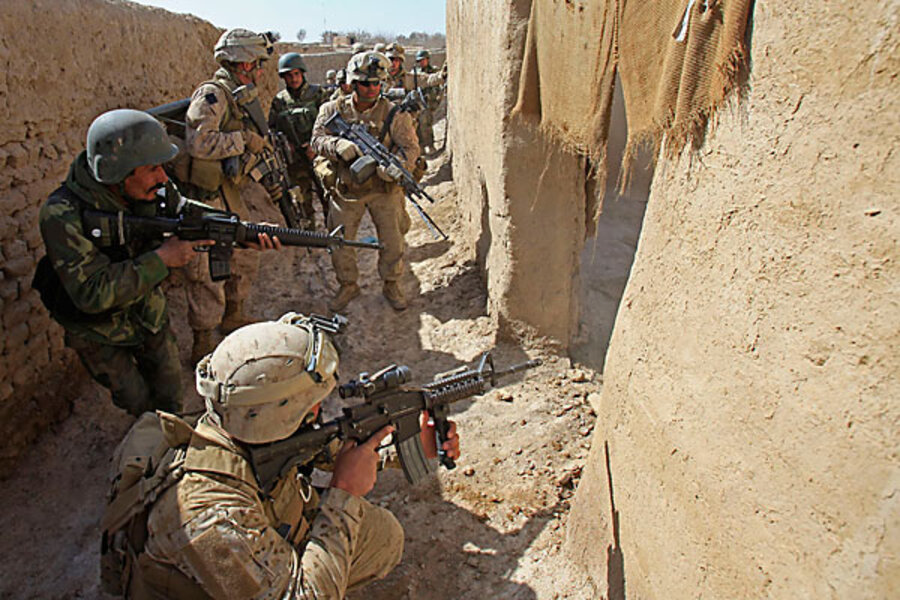Capture of Taliban No. 2 bolsters US efforts in Afghanistan
Loading...
| Washington
The recent capture of the Taliban’s No. 2 official could bolster American efforts in its ongoing offensive in southern Afghanistan, experts say.
US and Pakistani officials have reportedly captured Mullah Abdul Ghani Baradar, the second in command in what is known as the Afghanistan Taliban.
Mr. Baradar has long been the top commander in the insurgency in Afghanistan that targets US, allied, and Afghan troops. His removal comes as the US mounts its largest offensive against the insurgency since 2001 in southern Afghanistan’s Marjah district in Helmand Province.
Baradar was picked up in recent days by the Pakistani intelligence service working alongside the CIA and other American officials last week, according to a report in The New York Times Tuesday.
Baradar has long been the head of the so-called Quetta Shura, the leadership council of the Taliban that fights in Afghanistan. The Shura council, however, is based in Quetta, Pakistan, and Baradar was apparently apprehended in Karachi. Pentagon officials would not comment on the newspaper report.
If Baradar is indeed out of the battlefield equation, his removal has both a tactical and a strategic significance, say experts. One tactical advantage may be the psychological impact his capture would have on enemy fighters engaged in the fight in Marjah, says Rick “Ozzie” Nelson, a senior fellow at the Center for Strategic and International Studies, a think tank in Washington.
“That may cause some individuals to reassess how they want to fight and if they want to fight,” says Mr. Nelson, a former naval officer.
Four days ago, American marines – along with Afghan army and police forces – mounted an operation in southern Afghanistan’s Helmand Province that is considered the largest since American forces first arrived in Afghanistan in the fall of 2001.
The operation is expected to clear the Taliban stronghold in Marjah, where up to 1,000 Taliban fighters operate. The offensive is also seen as an early test of President Obama’s new strategy in Afghanistan, which is putting an additional 30,000 American troops in Afghanistan by the end of the year.
Helmand is also home to much of Afghanistan’s poppy crop, which funds a significant percentage of the Taliban’s insurgency, and American military officers hope operations there could degrade the opium harvest, and therefore, the amount of funding for the Taliban.
If fighters decide to lay down their arms to consider reintegration with the Afghan government, that would be a significant development, experts say. It would allow the US to clear the area without much heavy fighting, thus reinforcing a primary aspect of the new strategy: protecting the civilian population.
The US has struggled with the issue of such casualties because they undermine efforts in a counterinsurgency in which protecting the civilian population is critical. Under the new strategy, Gen. Stanley McChrystal, the top commander in Afghanistan, has said US forces should use utmost caution during operations, in some cases holding their fire rather than risking killing civilians by accident. The Marjah operation already included at least one such incident, in which an errant airstrike killed 12 Afghan villagers Sunday.
So far, the US and Afghan forces have met sporadic but intense resistance since beginning the operation, dubbed Moshtarak, a Dari word for “together.”
The capture of Baradar also holds strategic significance, as it appears to mark a new era in US-Pakistani cooperation in the common fight against the Taliban. The two countries’ on-again, off-again relationship over the years has usually been marked by mistrust and sometimes cross-purposes.
While the US has pushed Pakistan to go after the Afghanistan Taliban, of which Baradar was a principle, Pakistan has been more focused on the “Pakistan Taliban,” led by the Mehsud tribe.
The long-term impact of the capture is not clear. American officials will hope to glean important information about the insurgency from Pakistan, if not the whereabouts of the Afghan Taliban’s spiritual leader, Mullah Omar.
Killing or capturing top leaders of the insurgency can sometimes have only a mild effect, as top leaders are quickly replaced by lower-level insurgents. Baradar is not irreplaceable, but it will be hard to find an effective successor, says Nelson, comparing the task to that of replacing Gen. David Petraeus, commander of US Central Command in Tampa, Fla.
“He is not just a thug,” Nelson says of Baradar. “He is pretty good at what he does.”
----
Follow us on Twitter.





